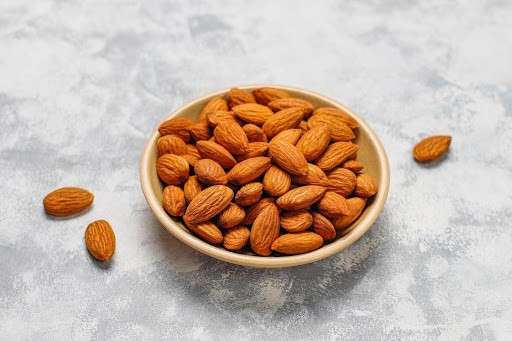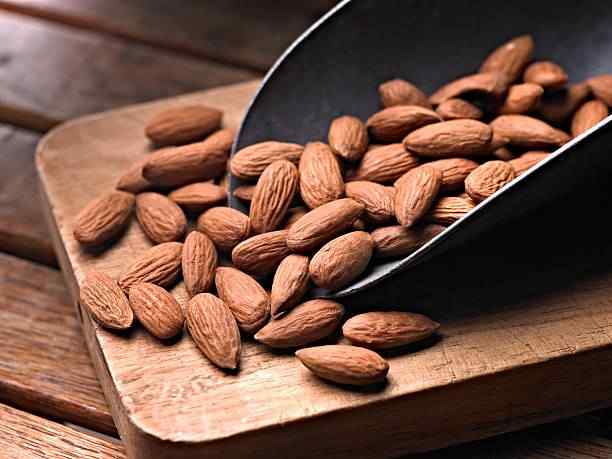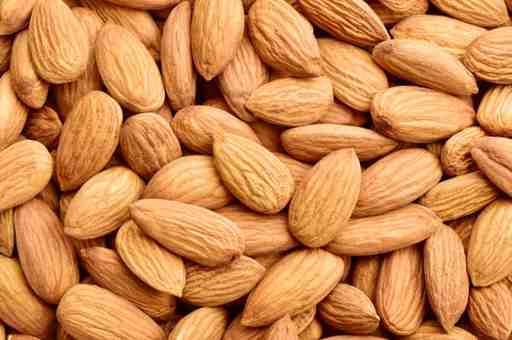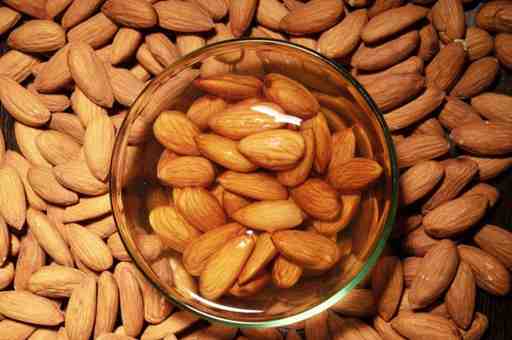Almonds: Health Benefits, Nutrition Facts, Uses!

Ever wondered how a nut like the almonds ended up being a commonplace thing all over the world? Whether the street stall in Mumbai or the expensive cafe in New York, the almond has crept its way and made it one of the most desired superfoods worldwide. They are everywhere: in granola, Diwali mithai box, protein shakes, and even skincare cream.
But why this humble nut? Who are the industry giants farming them? And why is India a world-famous country for its prosperous and diverse food culture experiencing such a colossal almond boom?
To crack and debunk the almonds’ bewildering universe, let’s dive deep and discover it.
What Makes Almonds the World’s Most Popular Nut?
Almonds make a crunchy snack, so you do not feel bored. But they also represent riches, health and the status quo in most societies. But what is that special ingredient that has made almonds almost everywhere?
A Nutritional Powerhouse That Ticks All Boxes
This is most noticeable in their nutritional make-up. Almonds have a greater dietary composition than most other nuts, which either carry fattening fat or loads of calories. They are rich in good monounsaturated fats, plant protein, dietary fibre, Vitamin E, magnesium and hundreds of anti-oxidants. This will make them perfect for nutritional goals- to lose weight, improve the heart, put on muscle, or even attain great-looking skin.
Almonds are cholesterol-free, gluten-free, and have a low glycemic index. They suit very well with the eating lifestyle in the day and age since they naturally integrate in the keto, paleo, vegan, and diabetic eating styles. Almonds are an exception in the world; they provide more healthful food that can be enjoyed without any thought about sinning.
Cultural, Historical, and Emotional Connect
However, almonds are not so popular only because of nutritional factors. This has also been boosted by centuries of cultural integration, which has made them very popular. Almonds have been something: prosperity, purity, and good luck since Persia to the sub-continent of India.
In India, almonds are present in wedding clothes chests, festival hampers, and even during religious ceremonies. Many may recall their mornings and parents as they are the ones who used to deceive their parents to take up wet almonds to have a good memory.
The use of almonds in classic almond desserts, wedding cakes, and feast occasions was commonplace around Europe and the Middle East centuries ago. They are not a thing of taste but history, tradition and a sense of continuity which no contemporary snack can offer.
Versatility That Fits Every Modern Lifestyle
Almonds are mostly taken in the highest quantities during the festivals and the celebrations like Diwali, Eid and Raksha Bandhan when population shares dry fruits among themselves, a gesture to show good health and affluence. Almonds can be added to any flavour and food trend, tossed in a smoothie, on a salad, ground into a flour to provide gluten-free baked goods, or eaten by the handful.
It is no wonder that almonds are being hailed in farm stands and high-end health stores, and they are the world’s favourite nut.

Which Country Produces the Most Almonds in the World?
With all that we know about why demand is skyrocketing, where exactly are all these almonds coming from? The resounding answer is in one place.
California: The Almond Capital of the World
California would be its capital if almonds were an empire that spanned the world. America’s California state alone produces an impressive 80% of the world’s almonds, a figure one cannot even conceive of when one observes the world’s consumption patterns. California alone yielded over 1.3 million metric tons of almonds in 2022, and it is the backbone of the almond supply chain.
This hegemony is explained by such phenomena as:
- Favourable Climatic Conditions: Almond grow in a Mediterranean climate that is warm and arid during winters and cold and wet during summers.
- High-tech Agriculture Techniques: California growers have been spending vast sums of money on the best irrigation systems and land conservation as well as crop investigation to achieve high yield and quality.
- Infrastructure and Market Integration: The California almond industry also has an integrated connection with export markets in the world, beginning with organized cooperatives and ending with high-tech processing facilities.
Other Players in the Almond Arena
While everyone focuses on California, other countries also offer much to offer. Spain, whose Marcona almonds are found in gourmet markets, is the leading almond-producing country in Europe. Australia has also rapidly initiated almond cultivation in its Murray-Darling basin and is a prominent exporter, mainly to Asia.
Iran and Morocco, with centuries of almond history, primarily provide home markets. None of them, however, comes close to California in size or technology. Nevertheless, their unique almond varieties contribute to world diversity and gastronomic selection.
How Big Is the Almond Market in India?
India’s affair with almonds is growing by leaps and bounds. Traditionally, a land of prolific farm yields, India relies on imports to fulfil its voracious appetite for almonds.
A Market That’s Only Getting Bigger
Recent statistics have indicated that India imports almost 100,000 metric tons of almonds annually, most of which California. Its imports are valued at more than 750 million dollars, a good indicator that the country is a massive consumer of almonds worldwide.
And it is not tapering off. With rising disposable incomes and faster urbanization, Indians are shifting towards healthier food habits in greater numbers. Favoured by fitness experts and dietitians who more often than not emphasize almonds in diets, the demand is now being felt from metro to tier-2 and tier-3 cities.
Festivals, Gifts, and Daily Diets
Almonds are normally used in highest quantity around the festivals and other functions such as Diwali, Eid and Raksha Bandhan in which people give dry fruits to the other people in order to show that they are healthy and wealthy. In:
- Morning smoothies and overnight oats
- School lunch boxes
- Corporate snack bowls
- High-end bakeries that produce macarons and almond cakes
- Health stores that carry almond milk and protein bars
Shifting From Traditional to Trendy
New technologies have rendered almonds even more widely available. Flavoured almonds—smoky barbeque, hot chilli, honey roasted are a hit with younger taste buds. Almond flour and almond butter are gaining traction in the gluten-free and vegan channels. Such diversification makes almonds non-seasonal but its commodity all year round.

Why Almonds are Called a Superfood?
The phrase, superfood is flung around quite loosely. But almonds earn their place with sound science to support it.
Packed with Macro and Micronutrients
What 100 grams of almonds provide:
| Nutrient | Amount | % of Daily Value |
| Calories | ~576 kcal | — |
| Protein | 21g | 42% |
| Total Fat | 49g | 75% (mostly healthy) |
| Fiber | 12g | 48% |
| Vitamin E | 25.6mg | 170% |
| Magnesium | 268mg | 67% |
| Potassium | 705mg | 20% |
The nutritional density gives almonds a lot of energy, and the needed vitamins and minerals for different body functions.
High in Antioxidants and Bioactive Active Components
Almond Skins are full of polyphenols that are enormous antioxidants that combat oxidative stress and inflammation. Not only is this essential when it comes to overall health but it also prevents the occurrence of chronic diseases like diabetes and cancer.
In addition, almonds have plant sterols, which form part of the cholesterol absorption barrier, which is an additional cardiovascular protective process.
What Are the Proven Health Advantages of Almonds?
The science-supported benefits of almonds are numerous and hold across many levels of health, making them the wellness all-rounder.
1. Heart Health Champion
Research certifies that taking almonds daily can lessen LDL (harmful) cholesterol levels, but does not affect HDL (good) cholesterol levels. The monounsaturated fats, flavonoids and magnesium contents are also high and aid in maintaining the heart’s health by eliminating atherosclerosis and the likelihood of heart attack.
2. Aiding Weight Management
It is factual that most people avoid nuts due to a wrong belief that they can make them fat. Levels of protein fibre and healthy fats in almonds lead to the feeling of satiety. It keeps a person satiated longer and minimises the number of unneeded snacks and the amount of calorie consumption. Almonds are time-consuming to chew, enhancing the fullness signals in the brain.
3. Managing Blood Sugar
An almond dessert is the best snack that a person with diabetes can have. They regulate insulin and blood sugar due to the low glycemic index and abundance of magnesium. It is also recommended to consume almonds with high-carb foods to curb the rise in blood sugar level after meals, which is an essential component in diabetes treatment.
4. Boosting Brain Power
Indian families have long felt that almonds soaked in water enhance the mind—science agrees. Riboflavin and L-carnitine helps in supporting the neurological function being abundant in almonds. Another abundant nutrient (Vitamin E) preserves the brain cells against the threat of oxidative stress, which reduces the chance of Alzheimer.
5. Glowing Skin and Strong Hair
Antioxidants and vitamin E present in almonds defend the skin cells against sun damage, skin age improvement and inflammation. Application of almond oil on the head rubbing on the scalp is known to fight dandruff and make hair stronger and shinier.
6. Strengthening Bones
Calcium, phosphorus and magnesium are contained in the almonds, and help maintain strong bones. The regular intake is associated with the enlarged bone mineral density, essential to kids, elderly people as well as individuals faced with a danger of having osteoporosis.

Almonds Price in India
Almond, also called as badam in India is a favorite dry fruit which is enjoyed for its exquisite nutrition and the healing properties of the badam by the people across the globe. The cost of almonds in India depending on various parameters quality, origin (from california or afghanistan or indian), its packaging, retail or bulk, etc. Wholesale mandi prices are on an average lower than branded or retail packs. Rates also vary by region and online platform. Here’s a latest update on the prices of almonds in India:
| Type | Quantity | Price Range (INR) | Source/Notes |
|---|---|---|---|
| Mandi Wholesale Almonds | 1 kg | ₹50 – ₹60 | Local wholesale markets |
| Indian Almonds (Retail) | 1 kg | ₹340 – ₹480 | Local stores/online |
| California Almonds | 1 kg | ₹500 – ₹750 | Premium imported almonds |
| Branded Almonds (Loose) | 1 kg | ₹830 – ₹1,200 | Healthy Master, BigBasket, etc. |
| Premium Organic Almonds | 1 kg | ₹1,200 – ₹1,450 | Flipkart, Amazon, niche health sites |
Is Almond Consumption Growing Among India’s Younger Generation?
Precisely. India’s youth population has recently been responsible for the almond boom. Unlike the older generation, who used to consume almonds essentially soaked in water under parental insistence, the young nowadays go out of their way to incorporate them as an indispensable part of the modern, balanced lifestyle.
There are several reasons behind this trend. One is the rapid escalation of the physical fitness culture in urban India. WIt does not matter whether it is marathons, gymming or the increased number of yoga studios, young Indians have never been so conscious about fitness and health. Almonds are a high-protein source of healthy fat, with almonds taking a front position as a go-to snack before or after a workout.
They are the crucial recovery food recommended by fitness trainers after working the muscles in a gym, and energy bars now come chock-full of almonds, as almonds have become the new staple known to accompany health smoothies and gym bags everywhere.
Number two is Gen Z and Millennials’ growing popularity of vegan and plant-based food. As lactose free, ethical or climate friend food is getting more popular, the substitutes take the form of almond milk, almond flour, almond butter, which are acquiring dedicated consumers.
In fact, almond latte is no longer an exception in the menu of urban coffee shops in Bengaluru, Mumbai, and Delhi whereas home bakers add almond flour to gluten-free cakes and cookies. It is also essential to have convenience.
The almond is easier and portably packaged than the average breakfast foods, but also easy and convenient- no need to worry about being in college or a young adult who enjoys studying and breakfasting in classes or known as the all-nighters. The ubiquity of the almond snack packs, energy bars, and granolas rich with almonds has established almonds as a convenient substitute for the hectic life of the 21st century.
Lastly, what used to be an elders’ health ritual is now being spread by young Indians, combining old wisdom with global health trends.
What Are the Challenges Faced by the Global Almond Industry?
Though popular, almond carry a formidable list of challenges that can determine the way they are accessible and for how much in the future.
Utilization of water is the most controversial one. Almond trees are extremely water hungry; one almond takes approximately 1.1 gallons (or an equivalent of 4 litres) of water. California is the largest producer of almonds in the world, with an immense load on the scarce water resources, particularly during dormant drought.
The critics say that dedicating such vast amounts of water to almonds makes no environmental sense. Farmers and scientists are therefore in a rush to design more water-efficient drip irrigation systems, soil detectors that sense drought, and drought-resistant almond varieties to mitigate the impact.
How is India Responding to the Global Almond Trend?
India is not sitting on its laurels as this almond revolution takes place. The country is still highly reliant on imports, a large portion of which come from California, but there is a movement to produce almonds domestically.
Such areas as Kashmir and Himachal Pradesh, where mild summers and cool winters are observed, were always appropriate for the almond farming industry. Historically, these regions have produced almonds to supply local markets, which is also happening. Still, with the increasing demand, more growers are finding almonds to be an attractive cash crop. This thrust is being assisted by agricultural departments distributing saplings, technical know-how, and information on disease management.
The overall trend of the Indian policy on nutrition, by initiating such schemes as a balanced diet plan at school and in rural families, has also indirectly boosted the demand for almonds. Dietitians have recommended almonds as a source of protein and micronutrients through health campaigns.
Thus, even though India may not threaten the position of California in the market shortly, it is working towards limiting its dependence and stimulating local almond output that fits in the immediate and global climate interests of consumers and food security.
Final Thoughts
Without question. Almonds are a nice compromise between the tradition of centuries and health awareness. They fit right in a grandma’s kitchen cabinet and a protein shake of a millennial.
With rising demand in countries across the globe and Indians’ obsession with this crunchy snack, almonds are sure to be a part and parcel of Indian families. They are not a mere snack but the pillar of healthy, successful, and transformed living and lifestyles, and they will go down to future generations.
Thus, next time you have a small handful of almonds, you will know that you are a part of a much greater escapade around the world- the one that connects the far Californian orchard, the Persian myth, and the Indian manners to your morsel.
Frequently Asked Questions (FAQs)
Q1. What are the benefits of almond?
Almond is a great source of healthy fats, fiber, protein, vitamin E, and magnesium. They are good for the heart, promote good brain health, maintain weight, and reduce cholesterol, these beans are something you can eat to maintain a good shape.
Q5. Are almonds safe to eat daily?
Yes, it is safe to eat almonds every day, as far as like, when it comes to moderation. They contain important nutrients such as vitamin E, fiber and healthy fats that benefit heart health, brain health and weight management. Food value : Eating 6 – 10 almonds daily results in thickening of hair.
Q6. What is the best time to eat almond?
The best time to consume almonds is in the morning, on an empty stomach. Soaked almond enhance nutrient assimilation, aids in digestion, benefit brain function, and even give you sustained energy, an all around great way to start the day!
Q7. Are almonds good for skin?
Yes, almond is good for your skin. Their abundance in vitamin E, antioxidants, and healthy fat content is known to nourish the skin, provide anti-aging benefits, prevent dryness and promote an original beauty through regular consumption or application over the skin.



